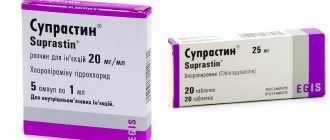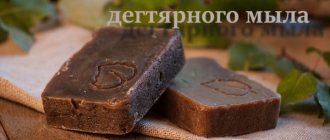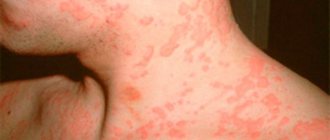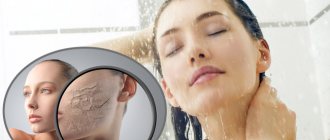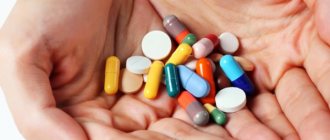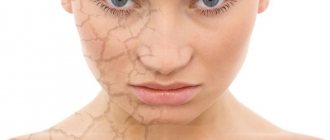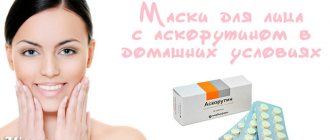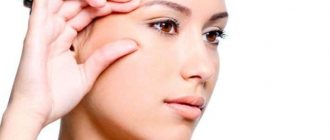The most common reason for allergies in a child is the genetic inheritance of the disease and an insufficiently strong immune system to fight the irritant. Under such circumstances, the child requires increased care and attention.
A competent approach to hygiene rules is the first step on the path to recovery. In this article we will look at what to bathe a child in if he or she has an allergy and how to deal with this disease.
Is it possible to get dermatitis wet?
Contact with water on the affected areas of the skin usually causes an increase in the symptoms of the disease, and also provokes the spread of the lesion to other parts of the body. To figure out whether it is possible to swim with dermatitis in an adult and a child, you first need to determine which type of disease was diagnosed:
- With atopic dermatitis, bathing is not only possible, but necessary. The main requirement that must be observed is the use of not too hot and not too cold water.
- With seborrheic dermatitis, exacerbation can occur due to the use of hard chlorinated water. If you replace it with soft spring or thermal water, unpleasant symptoms may decrease.
- For contact dermatitis, you need to pay attention to the condition of the skin after contact with hygiene products - shower gel, soap. Perhaps they are the culprits for the appearance of symptoms of the disease.
- Is it possible to swim if you have allergic dermatitis? First you need to establish what exactly causes the allergic reaction. If you use herbal infusions for bathing, be sure to inform your doctor about this: some plants are precisely the triggers of allergic dermatitis.
Bathing for contact dermatitis
Contact dermatitis differs from allergic dermatitis only in that it occurs as a result of direct contact with an allergen. Can I wash myself if I have contact dermatitis? If a person does not have a negative reaction to water, then the scheme for taking water procedures in this case will be the same as for allergic dermatitis. Otherwise, you need to contact a dermatologist to take allergy tests to identify a reaction to substances contained in the local water (since they are the ones that cause skin rashes). Persons whose illness is aggravated by contact with tap water are advised to switch to washing their faces with boiled or mineral water.
Folk remedies for safe bathing
Therapeutic baths for atopic dermatitis are quite effective. They help reduce inflammation in affected areas of the skin. The most common bath recipes include:
- Bath with birch buds and leaves, 200 gr. leaves and buds are poured with a liter of boiling water and infused for 3 hours. Next, strain and pour into the prepared bath.
- In the same way, a decoction of herbs such as celandine, violet, nettle, and string is infused.
- Bath of Cleopatra. A liter of milk is mixed with half a glass of unrefined olive oil. Pour the prepared mixture into the bath and take for about 15-20 minutes.
- Bath with sea salt. Add 5 tablespoons of salt to the bath and stir until completely dissolved.
- Starch bath: add 2-3 tablespoons of starch per liter of water. Pour the resulting mixture into the bath.
We invite you to familiarize yourself with Laser treatment of nail fungus - advantages and disadvantages of the procedure
What herbs to use for bathing
Pediatricians explain what to bathe a small child with allergies. Tinctures from plants are added to water to reduce external symptoms and make you feel better.
Herbs for bathing children with allergies:
- A series.
- Oregano.
- Birch buds.
- Chamomile.
- Currant petals.
Dried plants are poured with boiling water, infused for several hours, the liquid is cleaned and poured into the bath. The solution is used to wash if symptoms appear on the face. The skin of newborns is moistened carefully so that they do not choke. A fresh solution of potassium permanganate is used for bathing and filtered before adding to hot water. The substance is dissolved until a raspberry liquid forms and passed through a bandage.
The bath water turns pale pink after adding the solution. The crystals do not spill out into the bathing liquid because they cause a burn when touching the skin.
Contraindications for potassium permanganate:
- The skin is too dry and flaky.
- Bleeding wounds appear at the site of diaper rash.
- Rash, ulcers.
- Scratches or cuts on the skin.
The solution heals the skin, removes bacteria, and eliminates inflammation when properly prepared.
Types of rash:
- Hives are large red spots with blisters.
- Rash - small pimples and pimples that itch and peel.
- Papules - tissue compactions are felt tactilely, but are not always detected visually.
- Peeling appears in separate places, the child is constantly itching.
Bathing for allergies is necessary regardless of the type of dermatitis, doctors name restrictions, and parents adhere to them.
Adviсe:
- A moisturizer is used after the procedure.
- Bathing lasts 15-20 minutes.
- Chlorinated water has a bad effect on the well-being of allergy sufferers. Use filtered or boiled liquid.
How should and can you wash yourself if you have dermatitis?
The main requirement for water procedures for dermatitis is the use of special personal hygiene products that are as gentle as possible and soft water. It is easier for residents of rural areas to comply with this requirement, since in most cases they have access to well or spring water.
But what about city residents? City residents can be advised to do the following: let the water sit before bathing, boil it, or purchase a special filter attachment that fits onto the shower head and traps chlorine particles.
As for the water temperature and the duration of hygiene procedures for dermatitis, the optimal solution would be to take a bath or shower at a temperature of 37-38 degrees for 5-10 minutes. It is better not to stay in the water for longer than the specified time. If you choose between a shower and a bath, then it is better to give preference to the shower. Avoid standard alkaline detergents (use ph neutral detergents).
It is prohibited to use hard washcloths, anti-cellulite mittens and skin scrubs. Remember: areas affected by dermatitis should not be rubbed, so you will have to avoid such products during and after bathing. The same applies to rubbing your skin after taking a bath or shower. Avoid vigorous movements when drying: simply blot wet skin with a soft towel, allowing the moisture to be absorbed into the fabric.
You should not swim in swimming pools, as the water in them is usually very hard and contains large amounts of chlorine.
Is it possible to wash if you have hives?
The most important thing is to establish the cause of urticaria, so as not to cause a worsening of the condition, and here you cannot do without consulting a doctor. When an accurate diagnosis has been made, it is possible, and even necessary, to begin water procedures. If you have hives, you should bathe once daily.
Basic Rules
Bathing with urticaria requires attention to preparation and the process itself.
Treatment of urticaria
To successfully eliminate the symptoms of the disease, it is recommended to adhere to a hypoallergenic diet.
It is based on avoiding coffee, nuts, honey, chocolate, fish products, spices and food dyes - the strongest provocateurs of urticaria.
Eliminating the causes is the main way to combat the disease. In many cases, the disease immediately recedes. No drug treatment is required.
The use of ointments and antiallergic drugs gives only a temporary effect, but does not cure the symptoms.
During the acute course of urticaria, it is usually sufficient to use antihistamines and preventive measures.
Chronic urticaria requires more informed treatment.
To do this, you must consult a doctor.
Folk remedies for safe bathing
Contact dermatitis differs from allergic dermatitis only in that it occurs as a result of direct contact with an allergen. Can I wash myself if I have contact dermatitis? If a person does not have a negative reaction to water, then the scheme for taking water procedures in this case will be the same as for allergic dermatitis.
Otherwise, you need to contact a dermatologist to take allergy tests to identify a reaction to substances contained in the local water (since they are the ones that cause skin rashes). Persons whose illness is aggravated by contact with tap water are advised to switch to washing their faces with boiled or mineral water.
Is it possible to wash yourself if you have seborrheic dermatitis? Throughout the entire period of treatment of this disease, regular water procedures using special means are recommended, since this type of dermatitis can cause complications - pyoderma. These include drugs containing zinc, clobetasol propionate, selenium sulfide, ciclopirox or ketoconazole (prescription of drugs should be carried out by the attending physician to avoid side effects).
Since you will have to stop using shower gel and soap during treatment, it is recommended to replace them with gentle products that do not contain fragrances, dyes and parabens. In particular, you can use La Cree cleansing gel. It contains derivatives of avocado and olive oils, licorice and walnut extracts, hypoallergenic detergents - these components gently cleanse the skin without drying it out.
Proper water procedures will help you get maximum benefits and not worsen your skin condition:
- Duration of stay in water is no more than 20 minutes. The water temperature should be pleasant for swimming, 37-38 degrees.
- If you have dermatitis, do not wash in water containing chlorine. Tap water will have to be boiled or a special filter purchased.
- Do not swim in pools, as the water there is usually chlorinated.
- It is advisable not to take a bath, but to give preference to a shower.
- You should not use washcloths, various brushes or scrubs, as this may worsen the condition of damaged skin areas.
- Also, you should not wipe or rub yourself; you can only blot your body with a soft towel.
All bathing products used must not contain alkaline or allergenic components.
Since you will have to stop using shower gel and soap during treatment, it is recommended to replace them with gentle products that do not contain fragrances, dyes and parabens. In particular, you can use La Cree cleansing gel. It contains derivatives of avocado and olive oils, licorice and walnut extracts, hypoallergenic detergents - these components gently cleanse the skin without drying it out.
Traditional medicine is very effective here, and not only for adult patients. Herbs are less likely to cause reactions than medications. Wipe the affected skin with a cloth soaked in a solution of string (outside of bathing), and after water procedures, rinse the skin with water and potato starch to reduce itching.
It is possible and even necessary to bathe a baby with atopic dermatitis in order to maintain hygiene, however, it is important to consult a doctor so that he can explain exactly how to carry out water procedures.
All bathing products for atopic dermatitis can be divided into the following groups:
- Emulsions (Emolium, Oilatum).
- Oils (Aven, Mustela Stelatoria).
- Foams and gels (Trickzer bath, A-derma).
- Baths with herbal decoction.
The method of using special bathing products is usually described on the packaging. To prepare a therapeutic bath, traditional medicine suggests using herbs such as string, nettle, celandine, as well as burdock root, birch buds and leaves, milk and olive oil, sea salt and starch.
Before preparing a bath, you must check your individual intolerance to the components used.
Each bath should end with moisturizing the skin. For this it is recommended to use drugs; Bepanten, Panthenol, Derma and other similar ointments. To moisturize the skin throughout the day, you can use air humidifiers, or, in their absence, use special thermal water (Aven, La Roche-Posay).
We suggest you read How to distinguish psoriasis from dermatitis: seborrhea and psoriasis differences
Is it possible to take hot baths if you have allergies?
One of the common autoimmune pathologies in modern society is allergic diseases. Food and drug allergies, atopic dermatitis, and bronchial asthma are becoming more common. About 30% of people around the world systematically experience unpleasant symptoms. This “popularity” of allergic diseases is mostly associated with environmental problems, life in big cities, poor heredity and other unfavorable factors.
An allergy is a peculiar reaction of the body to allergens: food, medications, dust, chemicals, etc. It can equally occur in both adults and children of any age. The severity of such a reaction also varies - from minor itching of the skin and rashes to death - anaphylactic shock. Regardless of the type of allergen that provoked the development of an allergy in a person, it is important to take timely measures to treat it, since a long and progressive course of the disease can cause numerous serious pathologies.
The main thing in treating allergies is to suppress the main symptoms and achieve remission. To do this, you can use not only drug treatment methods, but also alternative methods of healing. The latter are increasingly gaining popularity among allergy sufferers, since antiallergic drugs, in the overwhelming majority, can cause unwanted side effects - decreased reaction speed, drowsiness, etc., and folk remedies made from natural herbs and plants cause a minimum of unwanted side reactions.
Alternative medicine accumulates the experience of many generations, and the recipes that our great-grandfathers used often form the basis of new techniques and modern drugs. However, there is an increasing interest in the use of herbs and other alternative remedies in their natural form in society.
Herbal treatment also requires certain knowledge, since many plants themselves are potential allergens. Therefore, before use, it is necessary to consult with an allergist in order to choose a folk remedy to which it has been established that there is no hypersensitivity. Otherwise, you can aggravate the course of the allergic reaction, aggravating the antigenic stimulation of the body.
Treatment of allergies using folk remedies is not only highly effective, but also more gentle on the body, based on natural ingredients that, unlike most antiallergic medications, do not put stress on the liver and kidneys.
What is the most important thing in treatment? Do no harm! Therefore, before resorting to alternative healing methods, you need to know the following:
- you need to be 100% sure that this is an allergic reaction. An itchy skin rash, for example, is not only a sign of allergies, but also a manifestation of infectious diseases. To make an accurate diagnosis, you must contact a qualified specialist;
- avoid contact with the allergen, otherwise antiallergic treatment will not give results;
- to prepare the products, it is recommended to use herbs purchased at the pharmacy;
- antiallergic therapy should be comprehensive. The use of folk remedies is not a reason to refuse medications. It is the competent use of folk wisdom and the achievements of modern medicine that gives the best results.
Help relieve allergic reactions and promote recovery:
- hypoallergenic diet;
- Fresh air;
- regular exercise;
- therapy of chronic diseases.
You can get confused when you see the number of folk recipes that are offered for the symptomatic treatment of an allergic reaction: lotions, tinctures, rubs, etc. The easiest option is to buy an herbal remedy for allergies at a pharmacy. Then everything is done according to the instructions indicated on the box.
Allergy ingredients often used in folk recipes are:
- mumiyo (solutions for oral administration and treatment of skin rashes);
- nettle;
- celandine;
- series;
- calendula flowers;
- fruits of fragrant dill;
- peppermint;
- wormwood;
- chamomile flowers;
- a mixture of dandelion root and burdock root;
- buds and leaves of white birch;
- tincture of hawthorn with valerian (it is recommended to use it internally for allergies, as a general tonic and sedative), etc.
Duckweed, vodka:
- wash fresh duckweed grass;
- pour vodka;
- let it brew for 7 days;
- take the drug 15 drops per 0.5 glass of water 4 times a day;
- course - month.
Cocklebur, water:
- pour boiling water over dried cocklebur;
- leave for an hour;
- drink tincture 1/3 of the total volume during the day;
- treatment – six months.
Chopped dandelion and burdock roots, water:
- pour water over the roots of the plants;
- leave to infuse for 10 hours;
- Boil the tincture and cool;
- Take half a glass before meals for 2 months.
Yarrow, water:
- Brew dry yarrow herb with boiling water;
- leave the decoction for half an hour;
- strain;
- drink 50 gr. 4 rubles/day.
Chamomile, dandelion root, rose hips, horsetail, centaury, St. John's wort, water:
- Pour boiling water over dried flowers;
- boil;
- wrap the broth in a towel and leave to infuse for 5 hours;
- strain the medicine;
- take a teaspoon daily;
- The recommended course is 6 months.
Dermatitis and sea water
The closer the holiday period is, the more adults and children with skin problems are interested in the answer to the question: is it possible to swim in the sea with dermatitis - atopic, allergic and others?
Many people note that during a vacation spent at sea, the symptoms of dermatitis decrease. The skin becomes less dry, itching and redness disappear. The reason for this change lies in the healing composition of sea water, which has a beneficial effect on the affected areas of the epidermis.
In addition to directly swimming in the sea, you need to take into account the positive effect of the marine climate. Air saturated with microdroplets gently affects damaged skin without causing harm.
It is recommended to choose the velvet season as a time for vacation. During this period, the difference between water and air temperatures is not as large as in July-August. As for choosing a holiday destination, you should give preference to European coasts: a sharp change in climate, which is observed when flying from Russia to Asian countries, Turkey and Egypt, can negatively affect the condition of the skin.
Experts' opinion
In general, it would be fair to note that in almost any case, even quite difficult ones, bathing will be useful .
As a rule, the optimal permissible time for the procedure depends on the complexity of the disease and the area of the affected areas.
The average allowable interval is 15 minutes .
You also need to pay attention to the fact that a shower with urticaria will be preferable to taking a classic bath, since in the first case there is a greater chance of not leaving damage to the skin and thus not aggravating its general condition.
Allergic urticaria is rightfully considered the most common. It is not contagious and does not pose a danger to others. In this case, if you have hives, and even need to wash
However, in order to avoid additional damage, you should remember how the hygiene procedure should be carried out. Let's consider the features of bathing with urticaria:
- swimming lasts no more than 20 minutes (ideally, it is better to keep it within a 15-minute period);
- the washcloth used for washing should be soft to the touch;
- It is good to use PH-neutral gels without fragrances as a detergent; regular baby soap can also be an alternative to these hygiene cosmetics;
- herbs help enhance the therapeutic effect of the procedure only if the patient is not allergic to them.
It is unacceptable to use hard washcloths, scrubs and other skin-damaging products, as in this case there is a risk of aggravating the disease. Shower gels with various additives can cause additional irritation on the skin, so their use at this time is also highly undesirable.
Good results in the treatment of urticaria can be achieved by taking a bath with decoctions of various herbs that have an antiseptic effect. But you need to keep in mind that herbal infusions can also cause allergic reactions. See recipes for medicinal baths and other folk remedies here.
Complications
If you neglect the problem and start treatment, dermatitis can have the following consequences:
- Deep ulcers on the skin;
- Purulent skin lesions (or pyoderma);
- Abscesses, purulent lesions of the subcutaneous fat layer.
This disease is not transmitted to another person and does not spread to healthy areas of the skin. However, there are cases where allergic dermatitis can be dangerous (if the allergen is poison ivy).
It is impossible to answer this question unequivocally, since everything will depend on the degree of neglect of the disease and the effectiveness of treatment.
Is it possible to swim with hives?
Let's consider whether it is possible to go to the bathhouse with hives and wash there, whether it is allowed to take a bath with a rash, steam in the bathhouse and sauna, and whether the hives become more active after the pool. These questions should not remain unanswered and explained, because human health depends on them.
What should hygiene be like when dealing with rashes?
Allergic urticaria, even with blisters, is not a contraindication to personal hygiene. Therefore, to the question of whether it is possible to wash, shower or bathe a child with urticaria, there is only one answer - it is necessary.
There is one important point that must be taken into account when you wash. If purulent papules appear on your body, then you should be diagnosed by a dermatologist to make sure that it is not a streptococcal infection. If your fears are confirmed, then follow your doctor’s recommendations on how to properly care for your skin and wash yourself.
But here’s what people suffering from hives should not do, regardless of the parts of the body on which there are rashes:
- Visiting the pool - water disinfecting reagents can cause even more severe irritation.
- Visiting baths and saunas should be left until better times. Sudden changes in temperature will not benefit skin affected by hives. And prolonged exposure to a humid environment can aggravate the disease.
- It is not advisable to wash in the bath. An exception is if decoctions of herbs that soothe affected skin (celandine, string, chamomile, calendula) are added to the water. The time for taking such a bath is no more than 15 minutes for adults and 10 minutes for children. You can wash no more than once a week.
- You should not swim in the bath if there are purulent pustules on your body. It's better to take a shower.
Bathing rules
Is it possible to get hives wet when you wash, especially if there are large blisters, is the most common question patients ask. Nobody canceled hygiene procedures even with hives. The question is how to wash properly:
- It's best to limit yourself to a shower. Water is not hotter than 37°C. This is the optimal water temperature that should be for irritated skin.
- Take a shower for no more than 15 minutes for adults and 10 minutes for children. While bathing, you can completely get rid of itchy skin.
- For the entire duration of the illness, mechanical influences such as washcloths, scrubs and peelings should be avoided.
- You should purchase shower gels with o. But even in this case, test it on a healthy area. Apply the gel to the inside of your elbow and leave for 12-24 hours. If there is no redness, then you can use it.
- After bathing, the body should not be dried. It is better to blot it with a soft terry towel or flannel diaper.
- After your shower, you can apply a moisturizing hypoallergenic body lotion that you have tested. This will improve the condition of the skin and prevent cracking, especially in areas affected by hives.
Therapeutic baths
Doctors are unlikely to prescribe special baths for urticaria. However, traditional medicine, which had no idea about antihistamines for centuries, but still cured urticaria, recommends therapeutic bathing as a panacea for this disease.
There are many recipes for decoctions made from herbs and remedies that are effective against allergic rashes in the form of urticaria. Let's look at some of them:
- For severely itchy rashes, traditional medicine advises taking healthy baths with baking soda twice a day. To do this, pour warm water into a regular bath, in which 400 g of baking soda are dissolved.
- Urticaria is successfully treated with nettles. To do this, brew a 100-gram pack of nettle in a 3-liter saucepan. Infuse the broth over very low heat for 1-1.5 hours. The richer the broth, the better. Pour the entire broth into the prepared bath and immerse in it for 0.5 hours. The itching goes away immediately. The skin becomes clearer after the first bath. A course of baths of 10 procedures will help get rid of chronic urticaria for a long time, and perhaps forever.
- Marjoram infusion added to the bath has a calming effect - relieves itching and heals blisters. Despite the fact that marjoram is not an allergy remedy, its decoction is very effective. The decoction is prepared very simply - 200 g of dry marjoram herb is added to 2 liters of boiling water. Then leave for 2 hours, wrapping the container with the decoction.
- A good bath is to add a decoction of a herbal mixture of St. John's wort, string and chamomile. Mix herbs in equal proportions. Pour 150 g of collection with three liters of boiling water. Simmer the broth over low heat for 1.5 hours. Pour the broth into the prepared bath and wash for half an hour.
Clinical researches
The conducted clinical study proves the high efficiency, safety and tolerability of products for daily skin care of children with mild and moderate forms of atopic dermatitis and during remission, accompanied by a decrease in the quality of life of patients. As a result of therapy, a decrease in the activity of the inflammatory process, a decrease in dryness, itching and flaking was noted.
Based on the results of the clinical study, the placement of information on the packaging “Recommended by the St. Petersburg Branch of the Union of Pediatricians of Russia” was agreed upon.
What treatment options are there?
There are many ways to treat the disease. The choice of method depends on the location of the disease:
- On the face . The most effective are pharmaceutical creams and ointments. Compresses on the face, especially on the eyelids, are applied with great care, since the skin of the face is very sensitive and delicate and can be damaged.
- On hands . Gels, ointments, folk remedies (lotions, compresses) are suitable.
- On the body . The affected areas are lubricated with ointments, gels and creams. However, in parallel with the use of these drugs, medicinal decoctions, herbal infusions and teas are ingested.
- On foot . To treat the affected areas, medicinal baths with the addition of herbal infusions are used, pharmaceutical creams and ointments, compresses and lotions are used.
It is recommended to take antihistamines. They will help eliminate redness and itching extremely quickly, no matter where in the body the disease appears. Such products are manufactured in the form of tablets and capsules.
Bathing for seborrhea
Is it possible to wash yourself if you have seborrheic dermatitis? Throughout the entire period of treatment of this disease, regular water procedures using special means are recommended, since this type of dermatitis can cause complications - pyoderma. These include drugs containing zinc, clobetasol propionate, selenium sulfide, ciclopirox or ketoconazole (prescription of drugs should be carried out by the attending physician to avoid side effects).
Advice! In case of exacerbation of seborrhea, it is recommended to wash the hair every 1-2 days and wash the face and body 2 times a day using medications prescribed by the attending physician.
Consumer Reviews
Marina Mironova (otzyvru.com)
“It so happened that my husband and I are both allergic, and our son’s allergy began to manifest itself from the maternity hospital - some kind of incomprehensible rash, then the skin became dry, I was afraid to use baby oil, and since I myself have been using La products for several years now - Cree, then she didn’t experiment with the baby either, and began using the “La-Cree” cleansing gel for bathing. What I like about it is that it is free of chemicals and hormones, and it cleanses delicate skin well and does not cause harm, which is very important for babies. And I use this gel to wash my face; after it, I have no itching, no flaking of my skin, this gel is now our common family remedy.”
Ana-ya otzovik.com
The La-Cri cleansing gel appeared in our house after a visit to an allergist. My eldest son (when he was 9 years old) developed acne on his shoulders. While we were undergoing tests to rule out allergies to detergents, the doctor recommended bathing and washing with this product. Our allergy turned out to be of “sweet” origin, but we continued to use the gel. When I was in the maternity hospital, I had to give soap, 10 diapers and wet wipes to the children's department (to care for my son, on the first day of his recovery). I gladly gave away this not yet started gel (thinking that it would take better care of my son's bottom). To my surprise, the next day, when they brought my son to me for good, no one returned the gel. I had to ask my husband to buy a new one. The ward mom said that they keep everything for themselves and they should have given something cheaper. Since birth I have been bathing my youngest son with this gel (now he is 3 months old). There are no allergies or rashes on the body. True, the shape of the dispenser is not very convenient when bathing a baby. But I got used to it. Cleansing gel “La-Cri” is a transparent liquid that smells something like a hospital ward after quartzing. I'm completely satisfied. We buy it at the pharmacy for 201 rubles. The instructions say that “has antiallergic, antipruritic, wound healing and anti-inflammatory effects. Approved for use in children."
Sources:
- B.A. Shamov, I.G. Safiullina, A.B. Beshimova, T.B. Shamov, Differential diagnosis of atopic dermatitis, journal of Practical Medicine, 2011 https://cyberleninka.ru/article/v/differentsialnaya-diagnostika-atopicheskogo-dermatita
- Fokina R.A., Atopic dermatitis: stages of development of classification forms, Siberian Medical Journal, 2007 https://cyberleninka.ru/article/v/atopicheskiy-dermatit-etapy-razvitiya-klassifikatsionnyh-form
- A.N. Pampura, A.A. Chuslyaeva, Modern approaches to the treatment of atopic dermatitis in children https:/cyberleninka.ru/article/v/sovremennye-podhody-k-terapii-atopicheskogo-dermatita-u-detey
Photos of dermatitis
Photo album on the disease
SKIN CARE FOR AN ALLERGIC CHILD
Atopic dermatitis
is an allergic disease.
Negative symptoms often appear in children in the first years of life. Redness of the skin, peeling, itching, cracks, crusts on the skin make babies and parents suffer. It is important to recognize the disease in time and, in case of complicated forms, to obtain advice from specialists. What are the effective measures for the treatment and prevention of atopic dermatitis in children? The main factors in the occurrence of the disease
are heredity and food allergies.
Contact with allergens also has a negative impact, they can be dust, pollen, and pet hair; chronic infectious diseases that provoke problems with the skin; frequent respiratory and viral infections, significantly worsening the immune system; transition from breastfeeding to artificial feeding. The goal of skin care for atopic dermatitis
is to maintain normal moisture, maintain or restore the protective layer, stimulate the growth of new cells instead of dead ones, and prevent irritation and damage to the upper layers of the skin.
SCIENTISTS HAVE FOUND THAT THE RISK OF GETTING ATOPIC DERMATITIS FOR A BABY FROM HEALTHY PARENTS IS NO MORE THAN 10-15%.
AT THIS TIME, IF ONE OF THE PARENTS HAD THIS DISEASE, THE RISK FOR THE CHILD INCREASES BY 50%, IF BOTH PARENTS - BY 80%. WHAT PRODUCTS SHOULD BE USED FOR MOISTURIZATION?
A baby with atopic dermatitis constantly needs emollients and moisturizers. During an exacerbation of the disease, they are applied to the skin up to 10 times a day, in normal times - 2-3 times a day. It is necessary to choose those cosmetics that simultaneously protect the skin from dryness and restore the lipid layer of the skin. These are emollient creams. Manufacturers usually write this on such products: “for dry, sensitive and atopic skin.”
DO NOT WIPE YOUR SKIN AFTER A BATH! IT IS EASY TO WET BLOTHED WITH A VERY SOFT TOWEL AND IMMEDIATELY, WITHOUT LEAVING THE BATHROOM, IN THE STEAM-RATED AIR, APPLY A SOFTENING-MOISTURIZER TO THE CHILD’S WET SKIN.
BASIC RULES FOR CARE OF THE SKIN OF AN ALLERGIC BABY
• Frequent bathing in good quality water (no chlorine).
• Moisturizing and nourishing the skin.
• Keep factors that aggravate the disease under control.
• Avoid exposure to irritating factors (perfumes, washing powders, synthetic fabrics).
• Avoid skin contact with hard, artificial fabrics and wool. Only natural, biologically pure fabric and clothing made from it should be placed on the body of an allergic child with atopic dermatitis.
• Monitor the temperature and humidity in the room (cool air with a humidity of at least 60%).
• It is also necessary to eliminate all “dust collectors” (cover bookshelves with glass, remove carpets, heavy drapes and curtains, duvets and pillows, etc.).
To enhance hydration and relieve irritation and itching, bath products AVEN (Trickzer bath), A-DERMA (bath product for atopic skin), LA ROCHE POSE (bath oil), BIODERMA (Atoderm oil) are added to the bath.
If bathing is contraindicated (acute period, wound healing) - micellar solution SENSIBIO H2 O from BIODERMA. Cleanser with a pH of no more than 5.5.
FOR CARE WE USE:
Mousses, creams, balms, thermal waters: BIODERMA (Atoderm line), AVEN (Trixera, Xerakalm lines), A-DERMA (Exomega line), URIAGE (Xemosis line), LA ROCHE-POSE (Lipikar line).
Disease prevention
Preventative measures include:
Products containing allergens should be avoided. Their diet should exclude food filled with dyes. Citrus fruits, sweets, eggs and dairy products should be consumed in limited quantities, as they are often the cause of allergic dermatitis.
- Overeating should be avoided . They often lead to this disease.
- Wet cleaning indoors should be carried out regularly. Dust should not be allowed to accumulate indoors. Dust negatively affects human health, especially those prone to allergic reactions.
Hygiene products, cosmetics needed select with special care.They should not contain fragrances, dyes, or various chemical additives, as such components lead to skin irritation and allergies.
- It is recommended to purchase clothes made from natural fabrics rather than synthetic ones.
- Taking vitamins . It will strengthen the body and increase immunity. This will help avoid allergic reactions.
- Moderate exercise . They will make the body strong and strong. The occurrence of this disease can be avoided.
- Rejection of bad habits.
Skin brighteners: is it worth using?
You can find recommendations for the treatment of atopic dermatitis using bleaching baths (with sodium hypochlorite - “Whiteness”). Data on the benefits of bleach baths is inconsistent. The theory is that a little bleach in the bath water can help kill bacteria and prevent skin infection. One tablespoon is enough. However, this is not suitable for everyone: the bleach fumes can irritate the lungs, so you should not try this if the patient has asthma or other lung problems.
Is it possible to sunbathe if you have allergies?
Increased sensitivity to ultraviolet radiation - photodermatosis - is considered a skin disease, and allergists do not classify it as an allergy as such due to the absence of a protein allergen... They believe that solar radiation only contributes to the appearance of allergic skin reactions that accompany other diseases or the use of certain types of medications.
But in the presence of diagnosed chronic atopic dermatitis - with exudative rashes, high levels of specific IgE antibodies and increased sensitivity to specific and nonspecific irritants - sunbathing in the sun, and especially in a solarium, is contraindicated.
Proper nutrition for allergic diseases, including those caused by certain foods, is the most important component of overall health.
When a person with such a pathology knows exactly what he can eat if he has an allergy and follows the doctor’s recommendations, he minimizes the manifestations of the disease and thereby improves the quality of his life.
Stages of eczema on the hands
As the disease develops, it goes through several stages:
- Erythematous stage – includes skin redness and itching;
The papulovesicular or vesicular stage manifests itself in the form of a rash of blisters with liquid;
Weeping eczema. During this stage, the bubbles burst, and in their place wounds form, releasing fluid;
- Crusting or dry eczema. At this stage, the wounds are covered with dry crusts of a grayish-yellow hue. At the same time, lesions may appear in other parts of the body.
What to do if the disease does not go away for a long time?
If the disease does not go away for a long time, the patient is prescribed more effective, stronger remedies . We are talking about antibiotics.
You cannot purchase them yourself. They are prescribed by a doctor only as a last resort.
If there is no improvement, it is recommended to consult a doctor, tell about the treatment performed and the lack of results. First, the patient will be prescribed more effective medications and a more detailed examination will be carried out.
Treatment in a hospital is possible . If the disease does not go away, you cannot self-medicate. You can harm your body even more. The help of doctors in this case is necessary.
Thus, this disease is serious and can greatly harm the body if left untreated. It is recommended to start treatment as early as possible in order to recover faster.
There are many treatment methods that effectively fight the disease. To avoid harming yourself, you should go to the hospital where the disease will be diagnosed. Timely treatment will help a person recover quickly and get rid of the disease.
To swim or not, that is the question
Cleanliness is the key to health. The widespread myth, supported even by individual doctors, that swimming is contraindicated, has no basis. It's definitely possible. Cleanliness is the key to health, not skin rashes. Constantly lubricated with ointment, the skin becomes covered with layers of sebum and sweat, microbes multiply on them, which does not contribute to recovery. Often after washing, red spots spread on the body, occupying a larger area than before contact with water. It is not difficult to avoid the spread of rashes by following the bathing rules:
What else can you bathe your baby in?
In maternity hospitals, the popular advice is to bathe infants in a weak solution of manganese. This advice has its roots in Soviet medicine, when children were fed every three hours regardless of when they wanted to eat, swaddled tightly and not picked up when crying, so as not to spoil them. Bathing in potassium permanganate only makes sense when the umbilical wound has not yet healed. This product disinfects the water and promotes slightly faster healing of the navel. The infusion is sold in the prescription department of the pharmacy. It’s better to buy it there than to buy dry potassium permanganate, infuse, strain, drain, strain again. Moreover, dry potassium permanganate has long been removed from public sale, since it was recognized as a precursor and included in the list of narcotic substances.
You can buy sea salt for baths at the pharmacy. This is a very good soothing product that saturates children's skin with various microelements, heals damage and relieves minor irritation.
After bathing in a solution of potassium permanganate and saline solution, the baby’s body must be rinsed with clean water.
allergiu.ru
Types of eczema on the hands
The cause of eczema on the hands can be a number of different factors - hormonal, immune, neurological, infectious. Therefore, depending on the cause, several types of the disease are distinguished, which differ in clinical manifestations, course and location of the rash:
True eczema is a type of disease that can be caused by various factors, and it is not possible to identify a single cause. True eczema manifests itself in the form of redness of the skin with a rash of small blisters with liquid, which soon burst and their contents spill out. Redness of the skin does not have clear boundaries; skin rashes are usually located on both sides and are symmetrical. The most common location of lesions in true eczema is the hands.
Microbial eczema develops due to infection of the skin by any bacteria, most often staphylococci and streptococci. Microbes produce toxins that serve as allergens for the body. In response, an allergic reaction develops in the form of redness, swelling and blistering. Eczema manifests itself in the form of asymmetrical scaly patches of skin and is often localized along the edges of trophic ulcers on the legs or non-healing wounds.
Is swimming always safe?
Indeed, in some rare cases it is worth refraining from water procedures, as they can greatly worsen the condition of the skin.
However, most often we are talking about an incorrect diagnosis.
If you have urticaria, you can most often swim and shower.
In order to understand whether it is possible to swim with hives or whether it is better to wait for a while, you need to know the cause of the appearance of skin rashes. If there is an allergic reaction, but it was not possible to determine what the allergy is to, you need to make sure that the reaction is not to tap water.
And if purulent urticaria , is it possible to wash? When the blisters on the skin are covered with ulcers, bathing is unacceptable. There is a risk of contracting various infections.
You should also pay enough attention to making a competent diagnosis, since in some cases you can visually confuse urticaria and streptococcal infection. If the latter is present, contact with water on the skin must be completely avoided.
